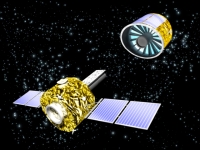Spacecraft
 |
|
Figure 5: Artist’s impression of the two XEUS spacecraft. The DSC (on the left) is actively formation flying to place the selected instrument at the prime mirror focal point. |
XEUS requires a focal length of around 35 m to reach a collecting area of 5 m2 at 1 keV. Given this long focal length, a dual spacecraft configuration is favoured. The MSC points the optical axis of the mirror at the target, using a classical AOCS with star trackers and cold gas thrusters (to avoid mirror contamination). The DSC keeps one of the focal plane instruments at the focal point of the mirror. In addition to star trackers which provide the primary attitude reference, its AOCS uses laser and RF rangefinders, with cold gas thrusters, to maintain formation flying. Both spacecraft are tracked from the ground station; the main downlink for instrument telemetry is in the DSC while the MSC transmits only housekeeping data. The mission will be designed to have an operational lifetime of at least 5 years.
Last Update: 1 September 2019

